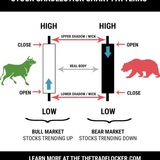✓ SubscribeSubscribers: 320
 RG Analitics 🟢 [PRIVATE CHANNEL🔒]
RG Analitics 🟢 [PRIVATE CHANNEL🔒]
Educational Post
What Is Risk Premium?
At its core, risk premium represents the additional compensation investors expect in return for taking on higher levels of risk. It serves as a quantitative measure of the premium or extra return required by an investor to justify investing in a riskier asset compared to a less risky alternative. Investors, in their pursuit of returns, grapple with the trade-off between risk and reward, and understanding risk premium is essential to making informed investment decisions.
How Does Risk Premium Work?
The concept of risk premium is best understood through the lens of different financial instruments, particularly bonds. Consider a scenario where an investor is comparing two bonds – one issued by a stable government with a low risk of default and another issued by a corporation with a higher risk profile.
In this scenario, the government bond, being less risky, would offer a lower interest rate or yield compared to the corporate bond. The difference in yield between the two bonds represents the risk premium. Investors will naturally expect a higher return for holding the riskier corporate bond, compensating them for the added uncertainty and potential default risk.
Risk Premium in Cryptocurrency Markets
The emergence of cryptocurrencies has introduced a new dimension to the concept of risk premium. Digital assets like bitcoin (BTC) and ether (ETH), characterized by high volatility and a relatively short market history, present unique challenges for investors.
In the context of cryptocurrency markets, risk premium can be substantial due to factors such as regulatory uncertainty, technological risks, and the potential for extreme price fluctuations. Investors in cryptocurrencies often demand a higher return to compensate for the inherent risks associated with this nascent and rapidly evolving asset class.
What Is Risk Premium?
At its core, risk premium represents the additional compensation investors expect in return for taking on higher levels of risk. It serves as a quantitative measure of the premium or extra return required by an investor to justify investing in a riskier asset compared to a less risky alternative. Investors, in their pursuit of returns, grapple with the trade-off between risk and reward, and understanding risk premium is essential to making informed investment decisions.
How Does Risk Premium Work?
The concept of risk premium is best understood through the lens of different financial instruments, particularly bonds. Consider a scenario where an investor is comparing two bonds – one issued by a stable government with a low risk of default and another issued by a corporation with a higher risk profile.
In this scenario, the government bond, being less risky, would offer a lower interest rate or yield compared to the corporate bond. The difference in yield between the two bonds represents the risk premium. Investors will naturally expect a higher return for holding the riskier corporate bond, compensating them for the added uncertainty and potential default risk.
Risk Premium in Cryptocurrency Markets
The emergence of cryptocurrencies has introduced a new dimension to the concept of risk premium. Digital assets like bitcoin (BTC) and ether (ETH), characterized by high volatility and a relatively short market history, present unique challenges for investors.
In the context of cryptocurrency markets, risk premium can be substantial due to factors such as regulatory uncertainty, technological risks, and the potential for extreme price fluctuations. Investors in cryptocurrencies often demand a higher return to compensate for the inherent risks associated with this nascent and rapidly evolving asset class.